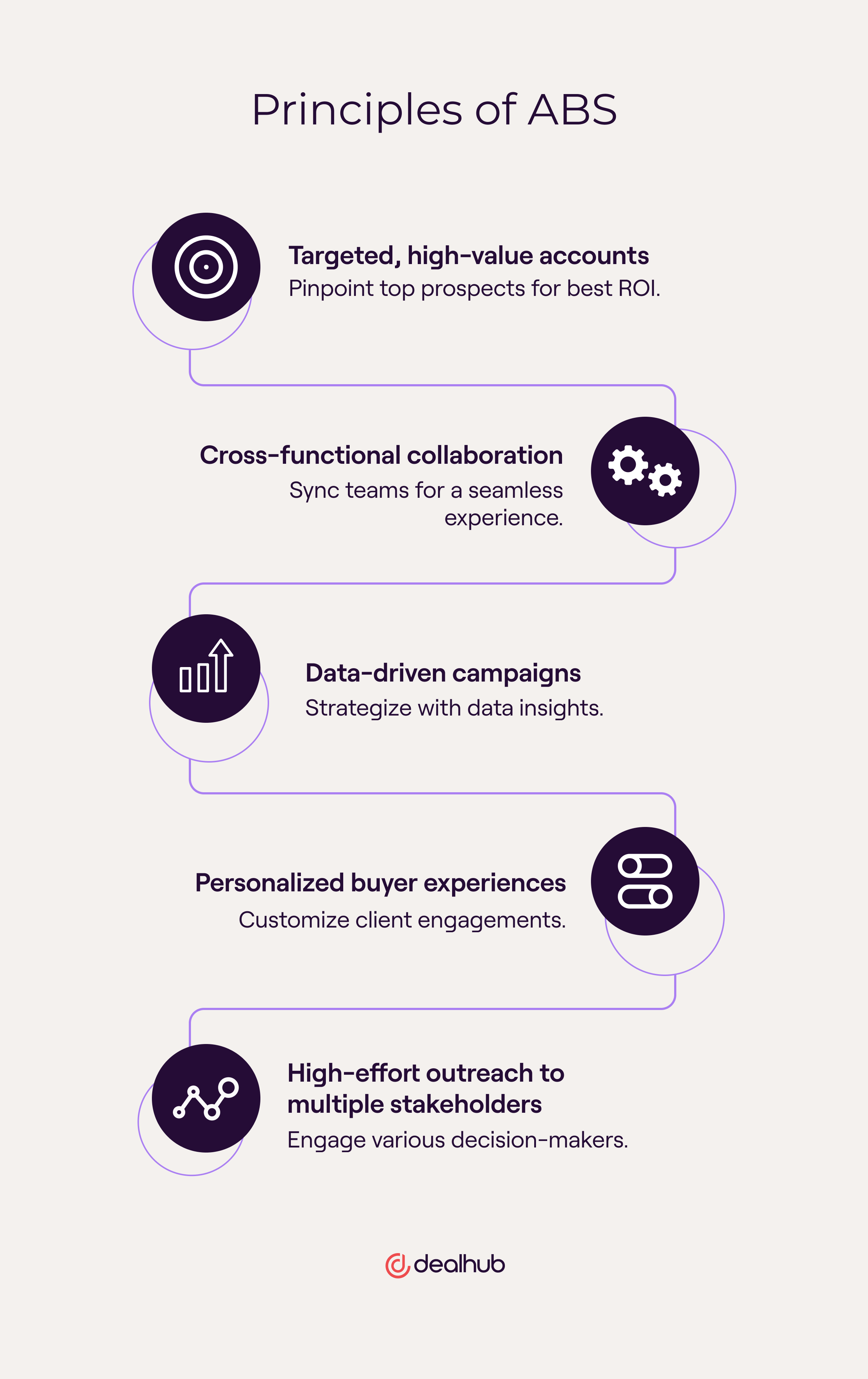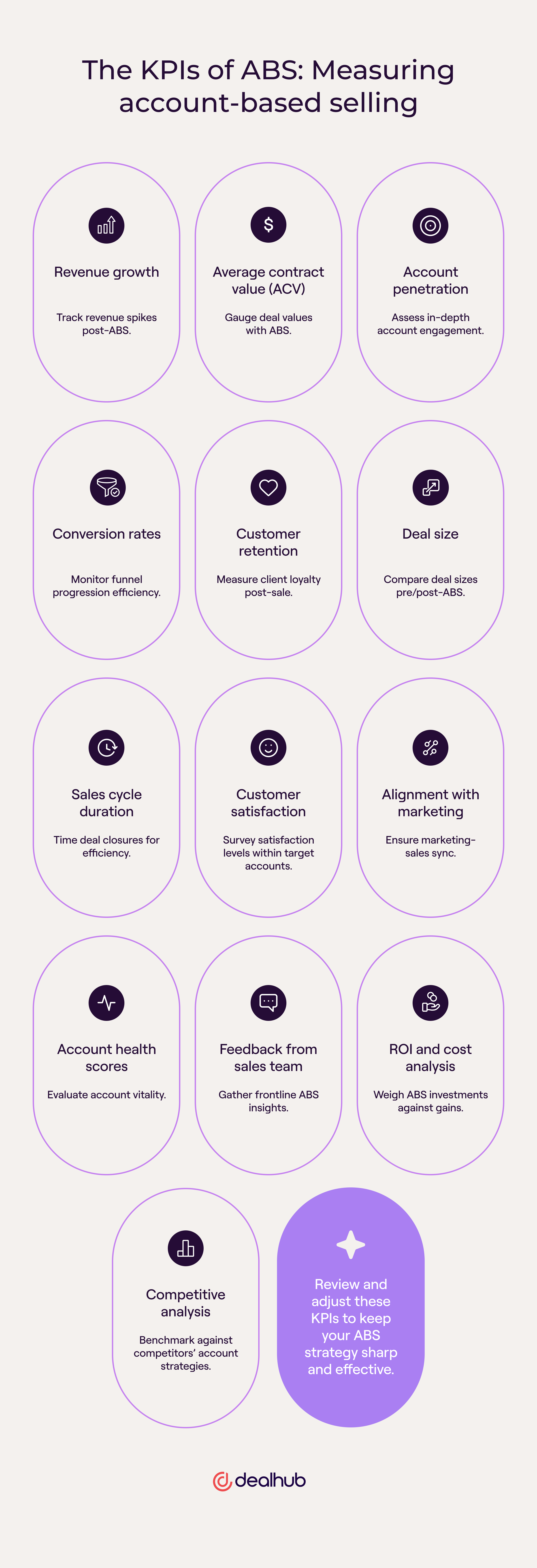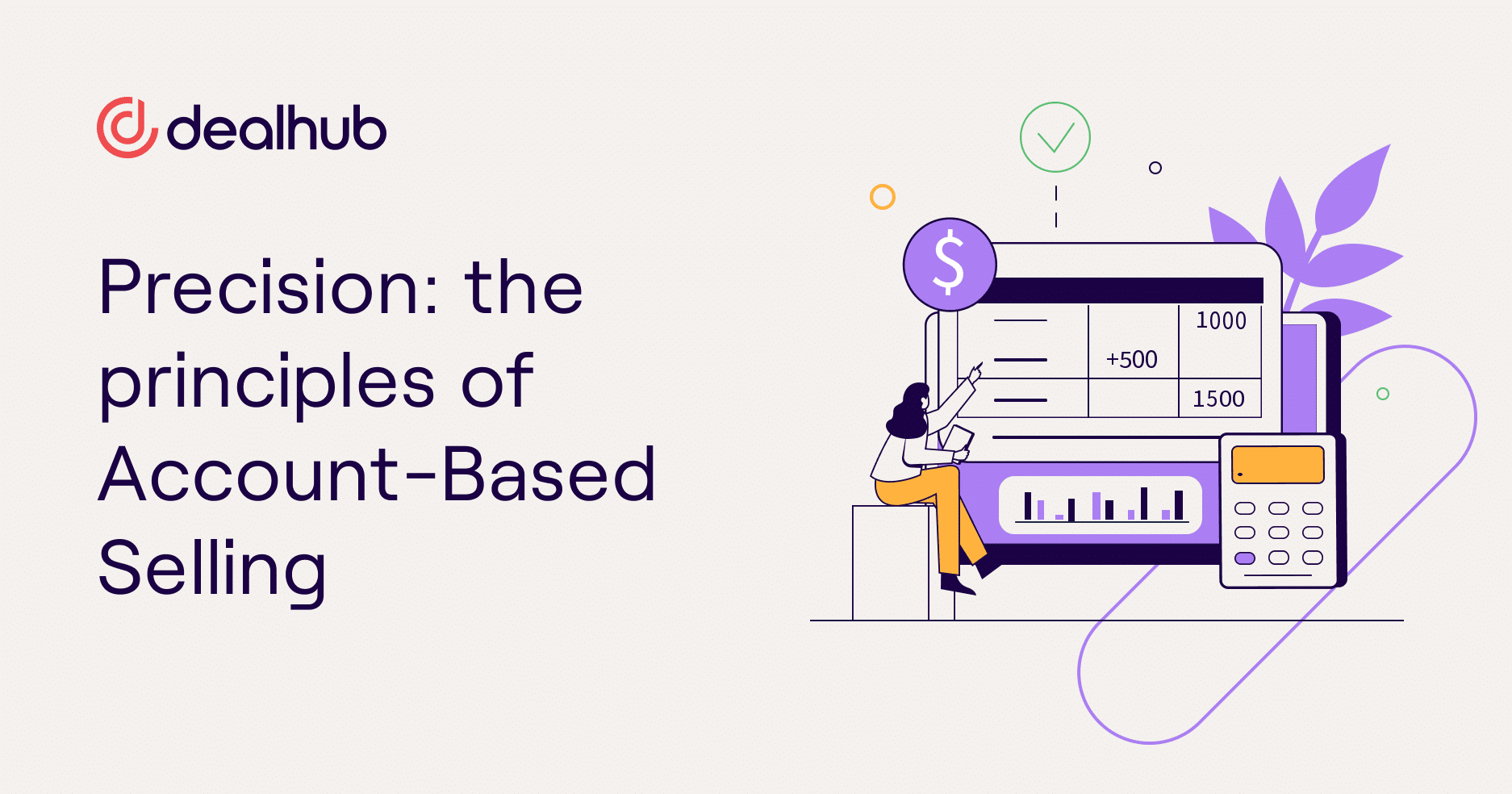Many of our customers have adopted this game-changing sales approach and shared what’s working for them. Today we’re shedding light on ABS’s intricacies and illustrating how businesses can transition from a scattergun approach to a meticulously targeted strategy that zeroes in on high-value prospects.
In this blog, you’ll uncover:
- The foundational principles of Account-Based Selling.
- Crafting bespoke outreach strategies that resonate with potential high-value clients.
- Best practices for inter-departmental coordination, ensuring a cohesive, potent engagement strategy.
- Real-world success stories that highlight the efficacy of ABS.
- How to measure ABS success.
Read on to master the art of targeted selling!
Precision: the principles of Account-Based Selling
Account-Based Selling isn’t just another sales methodology; it’s a paradigm shift in how businesses approach their sales process. At the heart of ABS lies a commitment to precision, ensuring that every effort is targeted, every strategy is tailored, and every outcome is optimized.

Principles of ABS:
Targeted, high-value accounts
Rather than prospect from a vast array of potential customers, ABS narrows the focus to those accounts that hold the most promise and align best with a company’s offerings. This targeted approach ensures that resources are utilized efficiently, leading to higher conversion rates and more significant returns on investment.
Cross-functional collaboration
Account-based sales isn’t a solo act. It requires the harmonious collaboration of marketing, sales development, sales, and customer success teams. When all revenue operations departments work in tandem, the client receives a consistent and cohesive experience, ensuring that no opportunity is missed and every touchpoint is impactful.
Data-driven campaigns
In the information age, account-based sales leverages data to inform its strategies. Every campaign is backed by actionable insights, from market trends to customer behaviors. Data-driven campaigns are more likely to resonate with the target audience, leading to higher engagement rates, average deal sizes, and more successful outcomes.
Personalized buyer experiences
ABS recognizes that every client is unique. Therefore, it emphasizes creating tailor-made solutions that address each target account’s specific needs and pain points. Personalized experiences lead to deeper client relationships, fostering trust and increasing the likelihood of long-term partnerships.
High-effort outreach to multiple stakeholders
ABS doesn’t just target a single decision-maker within an organization. It engages with multiple stakeholders, ensuring the value proposition is communicated across the board. By engaging with various stakeholders, ABS increases the chances of buy-in at multiple levels, providing a smoother sales process and reducing potential roadblocks.
Focused outreach for better results
Understanding your audience is the foundation of any successful sales strategy. With ABS, this principle is magnified. Focused outreach, rooted in a deep understanding of the Ideal Customer Profile (ICP) and buyer personas, can transform your sales outcomes.
The power of the ICP
Understanding the ICP is the cornerstone of creating an ABS strategy. It’s not just about knowing who to target but understanding their needs, challenges, and aspirations. With a clear ICP, businesses can craft specific buyer personas. This clarity ensures that outreach is targeted and resonates deeply with the potential client, addressing their unique challenges and needs.
Crafting buyer personas for meaningful engagement
Once the ICP is established, the next step is to develop detailed buyer personas. These personas represent the key stakeholders within the target accounts, providing insights into their roles, pain points, and decision-making processes. Engaging with these personas in mind ensures that communication is relevant, timely, and impactful.
Prospecting key decision-makers
In B2B sales, decisions are rarely made by a single individual. Hence, ABS emphasizes the importance of identifying and engaging with key decision-makers within target accounts. This ensures that the value proposition is communicated to those with the power to make purchasing decisions.
Embracing multi-threading for comprehensive engagement
Multi-threading, or interacting with multiple stakeholders within a target account, is a hallmark of ABS. It’s not just about reaching out to the primary decision-maker but ensuring that the value proposition is understood and appreciated across the board. This multi-faceted approach increases buy-in, reduces potential roadblocks, and amplifies the chances of a successful sale.
Cross-team collaboration best practices
The magic of ABS lies in collaboration. Marketing and Sales teams must join forces, crafting relevant content for prospective customers and sharing critical data to pinpoint the correct accounts. Moreover, the Sales and Customer Success bond ensures a lasting relationship post-sale, fostering trust and loyalty.
Let’s explore how different teams can harmonize their efforts for a seamless ABS execution.
Marketing and Sales
The synergy between Marketing and Sales is pivotal. While marketing teams craft compelling narratives and content tailored for target account lists, sales people reps ensure this content reaches the right stakeholders. Together, they ensure that the message is powerful and lands perfectly, resonating with the target buyers.
Data sharing
For ABS to be effective, data must flow seamlessly between teams. Marketing insights about target company behaviors, combined with Sales data on engagement levels, help in refining strategies. This shared data becomes the compass, guiding teams to the most promising opportunities and ensuring efforts are laser-focused.
Sales and Customer Success
The ABS journey doesn’t end with a closed deal. Sales and Customer Success must collaborate post-sale to ensure a smooth transition. While Sales provides insights into the client’s expectations and pain points, Customer Success takes the baton, ensuring these needs are met, fostering trust, and laying the groundwork for upselling or cross-selling opportunities.
Continuous feedback loops
One of the hallmarks of successful cross-team collaboration is continuous feedback. Teams should regularly share insights, successes, and challenges. This feedback loop ensures that strategies are constantly refined, mistakes are learned from, and successes are replicated.
Selling doesn’t end after the sale
In the ABS framework, closing a deal is just the beginning. The post-sale phase is equally, if not more, critical in ensuring sustained success and fostering lasting client relationships. The vital components of this extended journey are onboarding, nurturing, upselling and cross-selling, and product innovation.
1. Onboarding: A smooth onboarding process is the first step in ensuring client satisfaction post-sale. Ensuring the client understands the product or service, setting clear expectations, and addressing initial queries or concerns lays the foundation for a fruitful relationship.
2. Relationship nurturing: Maintaining regular communication with stakeholders is essential. It’s about addressing issues and celebrating milestones, understanding evolving needs, and ensuring the client feels valued. This continuous engagement builds trust and cements the partnership.
3. Upselling and cross-selling: With a deep understanding of the client’s needs and challenges, there are opportunities to introduce them to additional products or services that can add value. This isn’t just about increasing sales but about genuinely enhancing the client’s experience and meeting their evolving needs.
4. Feedback-driven product development: Finally, clients are a goldmine of insights. Their constructive feedback can guide product innovation and development, ensuring offerings remain relevant, competitive, and tailored to market needs.
ABS success stories
Let’s look at some real-world success stories that offer invaluable insights into the transformative power of Account-Based Selling.
At Furlough, a SaaS provider’s journey with ABS led to a remarkable 30% increase in sales within just six months. By zeroing in on their target accounts and personalizing their outreach, they not only achieved higher conversion rates but also built more profound relationships with their key accounts. Integrating advanced tools, from CRM software to marketing automation, played a pivotal role in refining and optimizing their ABS strategy.
Michelle Tuzman, former Senior Manager of Revenue Operations at Electric and currently Senior Manager of Retention Operations at Chief, joined the RevAmp podcast to discuss her success with ABS. She acknowledged the advantages of shifting her approach from a somewhat haphazard ‘spray-and-pray’ method to adopting ABS. This strategic approach involved pinpointing the target accounts, geographical locations, and specific industry verticals that empowered her sales team to acquire new customers efficiently. This transformation led to an increase in deal values and accelerated their sales cycle.
These narratives underscore the profound impact of ABS when executed with precision, strategy, and the right tools. How can you measure the success of your ABS strategy? Let’s explore the KPIs of ABS.
The KPIs of ABS: measuring account-based selling
Assessing the power of ABS requires revenue leaders to analyze these key sales metrics:

Revenue Growth: One of the most straightforward indicators of success is increased revenue. Compare the revenue generated from target accounts before and after implementing ABS. Ideally, you should see a significant increase in revenue from these accounts. A related metric is Average Contract Value.
Average Contract Value (ACV): Calculate the average contract value of deals closed with your target accounts. A successful ABS strategy should yield a higher ACV, as you’re focused on providing tailored solutions to high-value clients, often resulting in more substantial contracts. Comparing the ACV for target accounts with non-target accounts can provide valuable insights into the effectiveness of your approach.
Account Penetration: Measure how deeply your sales team has penetrated target accounts. This can be quantified by tracking the number of stakeholders engaged within the account, the number of solutions or services adopted, and the expansion of business within the account.
Conversion Rates: Analyze the conversion rates at various sales funnel stages. Look at how many target accounts move through each stage, from initial contact to closing the deal. Higher conversion rates indicate a more effective ABS strategy.
Customer Retention: ABS is not only about acquiring new accounts but also retaining and growing existing ones. Assess the churn rate for target accounts, as a lower churn rate signifies the effectiveness of your account-based approach in retaining customers.
Deal Size: Calculate the average deal size for target accounts compared to non-target accounts. A successful ABS strategy should yield larger deal sizes due to the focus on high-value clients.
Sales Cycle Duration: Measure how long it takes to close deals with target accounts. A successful ABS strategy should result in shorter sales cycles as you have a deeper understanding of the account’s needs and can provide more tailored solutions.
Customer Satisfaction: Survey target account contacts to gauge their satisfaction with your sales and service processes. High customer satisfaction clearly indicates success in delivering value to these accounts.
Alignment with Marketing: Account-based marketing and account-based selling work hand-in-hand. Evaluate the alignment between your sales and marketing teams. Successful ABS requires close collaboration between the two departments. Ensure that marketing is generating leads and content tailored to the target accounts.
Account Health Scores: Develop account health scores or customer engagement indexes to measure your target accounts’ overall health and engagement levels. This can help identify accounts that need attention and those that are thriving.
Feedback from Sales Team: Collect feedback from your sales team about the effectiveness of the ABS strategy. They are on the front lines and can provide valuable insights into what is working and what needs improvement.
ROI and Cost Analysis: Calculate your ABS efforts’ return on investment (ROI) by comparing the revenue generated with the costs incurred. Ensure that the benefits outweigh the expenses.
Competitive Analysis: Compare your performance with competitors in the same market and industry. A successful ABS strategy should outperform competitors in acquiring and retaining high-value accounts.
Measuring the success of an account-based selling strategy involves a combination of financial metrics, engagement data, and feedback from both your sales team and the target accounts. Regularly review these metrics to fine-tune your ABS strategy and ensure that it continues to drive growth and value for your organization.
An “always learning” mindset ensures success
In the sales world, the only constant is change. As market trends shift and customer preferences evolve, the ability to adapt becomes paramount. This is where the “always learning” mindset comes into play, ensuring that ABS strategies remain relevant, effective, and impactful.
Feedback loops play a crucial role in this continuous learning process. By actively seeking feedback, analyzing outcomes, and iterating based on these insights, businesses can refine their ABS approach. This iterative process, which encompasses both the highs of triumphs and the lessons from setbacks, ensures that the ABS strategy remains agile and responsive to the ever-changing market landscape.
ABS transcends the “personal selling” methodology. It embodies a philosophy that prioritizes targeted precision over sheer volume. It’s about ensuring that every outreach resonates, every engagement builds a relationship, and every sale paves the way for sustained success.









